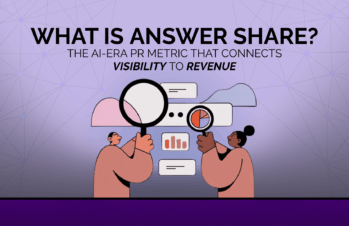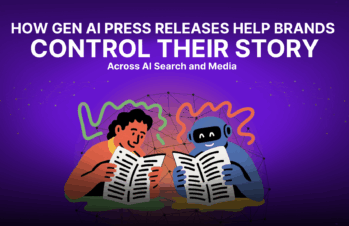Communications. Public relations (PR). Marketing. When you hear these three concepts, they sound synonymous, right?
Wrong!
While they share a few similarities, these three tools are all independent gears that rely on each other to operate your B2B brand’s integrated marketing communications machine as efficiently and effectively as possible.
In the world of PR and marketing, a lot of industry jargon gets thrown around and used interchangeably, confusing clients and potential consumers. (If you need a jargon refresher, check out our glossary.) Muddling these terms and their role in your marketing strategy can give you a false sense of security for your business when you may actually need help.
To know how to use each to your brand’s advantage, you must understand what they really are and where you can apply them to grow your business.
A rule of thumb to always remember: marketing is not communications, and communications is not marketing. And if you’re unsure where public relations fits into all this, we can help you out there too.
The Definitions: Corporate Communications vs. Public Relations (PR) vs. Marketing
Before we dive into the ways these different tools work together, it’s important to understand how each one individually contributes to your overall marketing efforts.
Corporate Communications
Sometimes referred to as strategic communication, this vertical involves the internal and external communication of the company, including employees, investors, stakeholders, the executive team, and sometimes other variations. It mainly deals with issue management, mergers and acquisitions, litigation, corporate-to-client communication, and so on.
This means corporate communication professionals have a constant pulse on all the activities going on within the company to keep it running smoothly.
Before you can showcase your brand to the world, you have to ensure everyone on your team is on the same page. Your mission, company values, and goals should be ingrained into your business and everyone that’s part of it. This is because corporate comms focuses on taking the brand that was developed in marketing and sharing it strategically both internally and to clients to ensure consistency and unity.
After all, good communication increases morale, upholds your company’s credibility, establishes your brand image, supports community relations, builds interdepartmental bridges, and encourages transparency.
Related Reading: Here’s Why Consistency is Key When it Comes to Your Brand
Public Relations
PR focuses on engaging with the general public through the media to boost the identity and visibility of a brand. This is where earned media—press releases, press hits, PR campaigns, podcasts, interviews, features, and so on—plays a significant part in gaining your business attention, credibility, and ultimately leads and sales.
Where corporate communication is centered around brand building, strategic public relations is all about the image and how to preserve it in the eyes of the public. This function can be defined as a deliberate, planned, and continuous attempt to build and maintain mutual understanding between a company and the general public, commonly known as media relations. The public’s impression of any organization plays a crucial role in its success, so finding a PR team capable of controlling the narrative the public hears is also essential.
PR professionals are responsible for managing an organization’s reputation and must be skilled in maintaining good relationships with various reporters and publications for their specific clients. They are also responsible for damage control with the public if your brand faces a reputation crisis or backlash that could tarnish the company’s image—one of the reasons why it’s pretty important to know you have a stellar PR team skilled in crisis communications on your side.
Related Reading: Build a Successful B2B PR Strategy
Marketing
Last, but certainly not least, B2B marketing encompasses strategies and initiatives that promote your brand’s products or services to a target audience—existing customers, prospects, potential investors, and more. It details why consumers should come to you with their needs (i.e., what makes your product or service better than the rest).
A successful marketing strategy includes, but is not limited to:
- Brand development
- Social media
- Content marketing
- Paid Ads (PPC)
- Email marketing
- Event marketing
These digital marketing efforts aim to highlight what your products or services bring to the table. You want to show new and loyal customers your benefits, features, and differentiators as well as advertise discounts and sales promotions that fit your business objectives, and lead them down the sales funnel to making a purchase.
Now that we’ve covered the definition of each, let’s examine what they have in common.
How Communications, Public Relations, and Marketing Work Together
Despite their differences, there is overlap within each field’s required duties and roles for your brand.
The most obvious is that all three require the ability to communicate effectively—both verbally and in written form—to connect and engage with other industry leaders, brands, customers, media outlets, influencers, and more.
But beyond the similar skill sets, corporate communications, public relations, and marketing all play a different part in advancing a brand. Collectively, these three elements aim to develop, share, grow, fortify, preserve, and advance a brand, which requires collaboration at all times.
But truth be told, while these three roles are all interrelated, two are distinctly more connected—and this is the part that many people get wrong.
The Value of a Corporate PR Strategy
While many lump PR in with communications, the truth is that corporate PR should be part of your marketing strategy.
Here’s why:
Communications is about sharing company news internally and with clients, and press releases are often a part of that. This is why many believe PR should fall under the comms umbrella.
But looking back at the public relations description we shared above, it’s clear that much like digital marketing, PR is focused on increasing brand awareness to the public, building a brand’s credibility, sharing its story, and amplifying what it offers. These goals 100% align with marketing, and the truth is, the best marketing campaigns are intertwined with PR.
Marketing covers paid, rented, and owned media, while PR tends to focus on earned media. Each media type needs to be incorporated into a holistic strategy to make the biggest impact.
Understanding the Messy Middle
We used Google’s study on the Messy Middle to help us map the buyer’s journey—and as the name implies, it’s messy. The more effective way for a brand to reach their target buyer amidst the mess is the right mix of paid, rented, earned, and owned media—and that means marketing and PR living under one roof.
Each of these components has their place and time in the buyer’s journey, with some components having short-term payoffs while others play the long game. The key is knowing when to implement each part of the strategy and how they all fit together.
While marketing and PR work hand in hand, it’s important to note that they also partner with comms teams to make sure that the hard work they do to bring leads and potential employees to the brand doesn’t stop at conversion.
Communications teams pick up where marketing and PR leave off, picking up the torch and becoming the internal champion for the brand. One cannot replace the other. They each target a specific area to bring maximum benefits to your organization.
Related reading: The Four Types of Media: Rented, Owned, Paid, Earned
Adding a Corporate PR Strategy to Your Mix
As we’ve discussed, corporate PR combines elements of both public relations and corporate communications but with a specific focus on managing relationships with key stakeholders who directly impact business operations. This specialized form of PR concentrates on building and maintaining a positive image, specifically among investors, business partners, industry analysts, and regulatory bodies.
To do this, corporate PR strategies typically include:
- Financial communications and investor relations
- Crisis management for corporate-level issues
- Executive communications and thought leadership
- Corporate social responsibility (CSR) initiatives
- Regulatory affairs and government relations
What makes corporate PR stand out is its focus on key stakeholders who directly impact business operations rather than end consumers. While consumer-facing PR might emphasize product benefits or lifestyle elements, corporate PR zeroes in on business performance, governance, and market positioning.
B2B PR vs. B2C PR: Understanding the Distinction
The world of public relations contains two primary branches that require distinctly different approaches: B2B (business-to-business) and B2C (business-to-consumer) PR (also known as corporate and consumer PR). Understanding these differences is crucial for developing effective communication strategies.
B2B PR: Building Professional Relationships
B2B public relations focuses on reaching decision-makers and professionals within specific industries. This approach prioritizes establishing credibility, demonstrating expertise, and showcasing business value. The ultimate goal is creating trust among fellow businesses, industry influencers, and key stakeholders.
Key characteristics of B2B PR include:
- Content that emphasizes ROI, efficiency, and business outcomes
- Longer decision-making cycles requiring sustained relationship building
- Communication targeting multiple stakeholders within an organization
- Industry-specific publications and channels as primary media targets
- Thought leadership as a cornerstone strategy
- Technical language that speaks directly to industry professionals
Establishing a strong B2B PR strategy can lead to higher conversion rates and shorter sales cycles compared to competitors without strategic PR programs.
B2C PR: Appealing to Individual Consumers
By contrast, B2C public relations targets individual consumers, focusing on emotional connection, brand recognition, and immediate action. Effective PR strategies under this approach emphasize lifestyle benefits, personal values, and creating memorable brand experiences.
B2C PR typically features:
- Emotionally resonant messaging that connects with personal values
- Emphasis on lifestyle benefits rather than technical specifications
- Broader media targets including mainstream publications and influencers
- Visual and story-driven content designed for higher engagement
- Simplified messaging accessible to general audiences
- Calls to action focused on immediate consumer response
An effective B2C PR campaign can help create a positive reputation and increase brand recall for your target audiences.
Related reading: What Motivates Buyers: Practical Strategies to Reach B2B and B2C Consumers
Strategic Implications for Your Business
Understanding whether your organization needs a consumer or corporate PR campaign—or perhaps both—directly impacts your communication strategy. Many companies operate in hybrid environments, requiring tailored approaches for different audiences.
The key is recognizing that these aren’t merely different channels but fundamentally different communication philosophies. A corporate PR strategy mistakenly applied to a consumer audience will often seem overly technical and fail to connect emotionally, while B2C approaches in B2B environments may appear superficial and lacking substance.
For organizations navigating both worlds, creating distinct PR strategies that align with each audience’s expectations and decision-making process is essential. This might mean developing separate content pipelines, media relationships, social media strategies (think: a separate persona for LinkedIn versus Instagram), and success metrics for each audience segment.
Bringing It All Together
Understanding the distinctive roles of corporate communications, public relations, and marketing—along with specialized approaches like corporate PR and the B2B/B2C distinction—creates a foundation for a truly integrated communication strategy.
When these elements work together harmoniously, your organization can maintain internal alignment, project a consistent external image, and effectively engage every audience that matters to your business success. This integration becomes particularly powerful when each function understands its unique role while supporting the broader organizational goals.
Need help making sure your marketing and PR teams are two peas in a pod? Want to learn more about how marketing and PR can collaborate with your comms team to drive holistic success? Let’s talk.
We’re always here to help.




